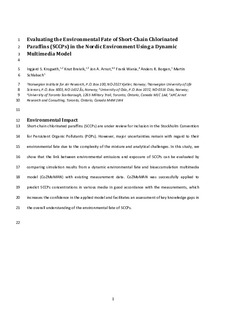| dc.contributor.author | Krogseth, Ingjerd Sunde | |
| dc.contributor.author | Breivik, Knut | |
| dc.contributor.author | Arnot, Jon A | |
| dc.contributor.author | Wania, Frank | |
| dc.contributor.author | Borgen, Anders | |
| dc.contributor.author | Schlabach, Martin | |
| dc.date.accessioned | 2017-11-15T08:25:09Z | |
| dc.date.available | 2017-11-15T08:25:09Z | |
| dc.date.created | 2013-09-24T10:27:57Z | |
| dc.date.issued | 2013 | |
| dc.identifier.citation | Krogseth, I.S., Breivik, K., Arnot, J., Wania, F., Borgen, A.R., Schlabach, M. (2013). Evaluating the environmental fate of short-chain chlorinated paraffins (SCCPs) in the Nordic environment using a dynamic multimedia model. Environ. Sci. Processes Impacts, 15, 2240-2251. doi:10.1039/C3EM00407D | nb_NO |
| dc.identifier.issn | 2050-7887 | |
| dc.identifier.uri | http://hdl.handle.net/11250/2466317 | |
| dc.description.abstract | Short chain chlorinated paraffins (SCCPs) raise concerns due to their potential for persistence, bioaccumulation, long-range transport and adverse effects. An understanding of their environmental fate remains limited, partly due to the complexity of the mixture. The purpose of this study was to evaluate whether a mechanistic, integrated, dynamic environmental fate and bioaccumulation multimedia model (CoZMoMAN) can reconcile what is known about environmental emissions and human exposure of SCCPs in the Nordic environment. Realistic SCCP emission scenarios, resolved by formula group, were estimated and used to predict composition and concentrations of SCCPs in the environment and the human food chain. Emissions at the upper end of the estimated range resulted in predicted total concentrations that were often within a factor of 6 of observations. Similar model performance for a complex group of organic contaminants as for the well-known polychlorinated biphenyls strengthens the confidence in the CoZMoMAN model and implies a relatively good mechanistic understanding of the environmental fate of SCCPs. However, the degree of chlorination predicted for SCCPs in sediments, fish, and humans was higher than observed and poorly established environmental half-lives and biotransformation rate constants contributed to the uncertainties in the predicted composition and ΣSCCPs concentrations. Improving prediction of SCCPs composition will also require better constrained estimates of the composition of SCCP emissions. There is, however, also large uncertainty and lack of coherence in the existing observations, and better model-measurement agreement will require improved analytical methods and more strategic sampling. More measurements of SCCPs levels and composition in samples from background regions are particularly important. | nb_NO |
| dc.language.iso | eng | nb_NO |
| dc.title | Evaluating the Environmental Fate of Short-Chain Chlorinated Paraffins (SCCPs) in the Nordic Environment Using a Dynamic Multimedia Model | nb_NO |
| dc.type | Journal article | nb_NO |
| dc.type | Peer reviewed | nb_NO |
| dc.description.version | acceptedVersion | nb_NO |
| dc.rights.holder | © The Royal Society of Chemistry 2013 | nb_NO |
| dc.source.pagenumber | 2240-2251 | nb_NO |
| dc.source.volume | 15 | nb_NO |
| dc.source.journal | Environmental Science: Processes & Impacts | nb_NO |
| dc.identifier.doi | 10.1039/C3EM00407D | |
| dc.identifier.cristin | 1051589 | |
| dc.relation.project | Norges forskningsråd: 196191 | nb_NO |
| cristin.unitcode | 7460,60,0,0 | |
| cristin.unitcode | 7460,57,0,0 | |
| cristin.unitname | Miljøkjemi | |
| cristin.unitname | Atmosfære og klima | |
| cristin.ispublished | true | |
| cristin.fulltext | postprint | |
| cristin.qualitycode | 1 | |
